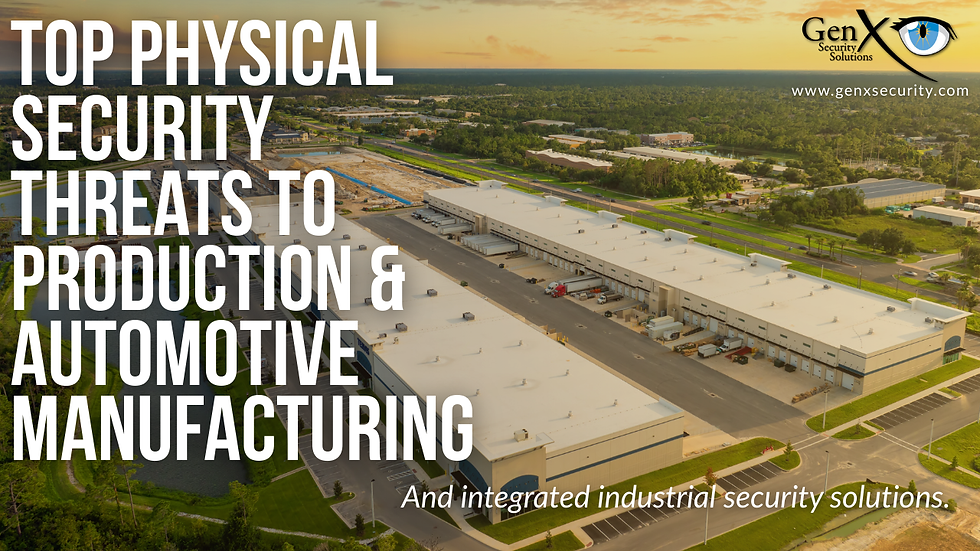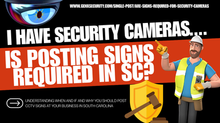For the Louvre of Security: What the Louvre Heist and Password Fail Reveal About Fragmented Security Systems
- GenX Security Solutions
- 6 days ago
- 5 min read

What the Louvre Heist and Password Fail Reveal About Fragmented Security Systems
In October 2025, the Louvre, one of the world’s most iconic museums, was hit by a shocking theft. Thieves stole $100 million in jewels from the Apollo Gallery in just seven minutes. How? Among other issues, the password for the surveillance system was simply "Louvre." It’s a dramatic example of how fragmented and outdated security systems can open the door to disaster, literally. If a globally recognized institution like the Louvre can make these mistakes, what does that mean for other high-value facilities?
Oh, Louvre, Vulnerability Wasn't a Strength Afterall
This wasn’t a failure of one system — it was the result of multiple breakdowns across infrastructure, decision-making, and priorities. Here’s what went wrong:
1. Louvre Hurts: When Passwords Lead to Chronic Insecurity
The Louvre made headlines for securing its surveillance system with one of the weakest passwords imaginable: "Louvre." This oversight allowed anyone with basic access or inside knowledge to potentially disable critical systems. It’s a textbook case of how cybersecurity failures can completely undermine physical safety.
Implement strict password protocols. Every device connected to a security network should require complex, unique passwords that are changed regularly.
Use multi-factor authentication. Adding a second verification layer, such as a mobile code or security key, would have made it nearly impossible for unauthorized users to gain access.
Segment security networks. Sensitive systems like surveillance should never share a network with public or administrative systems.
Conduct regular cybersecurity audits. A vulnerability scan or penetration test would have exposed weak credentials long before thieves did.
2. Lazy Coverage = Turning a Blind Eye to Problems
While the museum spanned hundreds of rooms, less than half were under surveillance. The specific gallery targeted during the heist had only one camera facing away from the breach point. Thieves exploited these gaps to enter, steal, and escape undetected.
Conduct a full site risk assessment. Mapping every entry, exit, and asset zone helps ensure complete coverage where it matters most.
Expand surveillance intelligently. Deploy additional cameras or motion sensors to eliminate blind spots, focusing on perimeter points and high-value zones.
Integrate monitoring into one system. Centralized video management software can alert operators instantly to camera malfunctions or off-angle feeds.
Regularly test and realign cameras. Scheduled maintenance ensures that surveillance equipment stays properly positioned and functional.
3. Red Flags Ignored Only Keep Toxic Options Open
Despite a 2015 audit warning of vulnerabilities, the Louvre delayed upgrades until 2024—with completion not expected until 2032. This created a long period of exposure where known gaps went unaddressed, giving criminals time to plan.
Prioritize fixes based on threat level. Once a vulnerability is identified, address the most critical risks first to minimize exposure.
Implement interim safeguards. Temporary mobile surveillance trailers or guard rotations can bridge the gap during upgrade projects.
Set clear security timelines. Long-term upgrades should have defined deadlines and accountability checkpoints to ensure consistent progress.
Allocate budget specifically for security maintenance. Treating security as a recurring investment, not a one-time project, prevents years-long vulnerability windows.
4. Systems That Don’t Talk Together, Fail Together
Alarms at the Louvre were triggered during the theft, but outdated and isolated systems failed to coordinate a real-time response. The museum's technology infrastructure, some of which dated back to the early 2000s, couldn’t deliver synchronized alerts or automation.
Unify physical and cyber systems. Integrate alarms, access controls, and video management under one modern security platform.
Upgrade outdated hardware and software. Regular updates ensure compatibility and remove vulnerabilities from unsupported systems.
Automate responses. A modern integrated system can trigger automatic lockdowns, redirect cameras, or alert law enforcement immediately.
Centralize monitoring. A single control hub allows for real-time situational awareness and faster response coordination.
5. Prioritizing Appearances over Stability
Internal reports revealed a consistent preference for public-facing projects like art acquisitions over essential but invisible security investments. This misalignment led to serious infrastructure neglect.
Include security leaders in financial decisions. Ensure the security team has a seat at the budget table to advocate for critical investments.
Treat security as brand protection. Prestige and safety go hand in hand — safeguarding assets is part of maintaining public trust.
Perform annual governance reviews. Evaluate how decisions around funding, procurement, and maintenance impact long-term risk.
Make safety visible. Leadership should communicate that proactive security investments are a mark of responsibility, not overreaction.
Lessons of Louvre: What happened at the Louvre became a heist at the Louvre. Sneaky links led to Louvre's betrayal.
All You Need Is Louvre? Not If It's Your Name and Also Your Password. It Can Happen to Your Business, Too
If the Louvre can be breached, so can you. The truth is:
Incomplete security coverage is a common risk.
Budget delays often outweigh risk assessments.
Disconnected systems create exploitable seams.
Siloed governance keeps security out of the loop.

Louvre's Lessons: Actions Speak Louder Than Words
Here are key actions you can take right now:
✓ Eliminate blind spots. Make sure every high-risk area is covered by surveillance and sensors.
✓ Use integrated systems. Combine video, access control, and alarms into one platform.
✓ Update your software. Outdated systems invite attacks.
✓ Train your staff. Cybersecurity mistakes can compromise physical safety.
✓ Align leadership. Security must be part of financial and operational planning.
GenX Security Solutions: Committed to Providing Security
At GenX Security Solutions, we specialize in eliminating fragmented systems. Our services include:
Fully integrated security platforms
Real-time video surveillance cameras and monitoring with mobile alerts
Secure, scalable access control
Custom assessments and risk audits
On-site support across South Carolina, North Carolina, and Georgia
We’re proud to serve Greenville, Myrtle Beach, Columbia, Charleston, Winston-Salem, and surrounding regions throughout South Carolina, North Carolina, and Georgia.
Ready for Real Security?
Don’t wait for a crisis to find out where your system fails. Contact GenX Security Solutions today for a free security integration assessment. Let’s make sure your defenses are complete, connected, and future-ready.

Experience the next generation of interactive security services and solutions with GenX Security.

With custom security integration solutions come custom quotes designed for your needs. Please contact us by clicking here or calling 866-598-4369.
At GenX Security Solutions, we proudly serve businesses in all locations across South Carolina, North Carolina, and Georgia with cutting-edge commercial security systems, access control solutions, structured cabling, fire alarms, and professional audio/visual integration. From bustling cities like Greenville and Raleigh to growing industrial hubs like Winston-Salem to hospitality hot spots like Myrtle Beach, our team delivers tailored solutions to meet your business’s unique needs.
Please visit our state-specific pages for more information on our services in various industries. We serve all cities in the Upstate and surrounding, including:
Aiken, SC | Asheville, NC | Alpharetta, GA |
Anderson, SC | Burlington, NC | Athens, GA |
Beaufort, SC | Cary, NC | Atlanta, GA |
Charleston, SC | Chapel Hill, NC | Augusta, GA |
Columbia, SC | Charlotte, NC | Carrollton, GA |
Florence, SC | Concord, NC | Columbus, GA |
Goose Creek, SC | Durham, NC | Dalton, GA |
Greenville, SC | Fayetteville, NC | Douglasville, GA |
Greenwood, SC | Gastonia, NC | Gainesville, GA |
Greer, SC | Goldsboro, NC | Hinesville, GA |
Hilton Head Island, SC | Greensboro, NC | Macon, GA |
Lexington, SC | Hickory, NC | Marietta, GA |
Mount Pleasant, SC | High Point, NC | Newnan, GA |
Myrtle Beach, SC | Jacksonville, NC | Peachtree City, GA |
North Charleston, SC | Kannapolis, NC | Rome, GA |
Orangeburg, SC | Raleigh, NC | Roswell, GA |
Piedmont, SC | Rocky Mount, NC | Sandy Springs, GA |
Rock Hill, SC | Wilmington, NC | Savannah, GA |
Spartanburg, SC | Wilson, NC | Valdosta, GA |
Summerville, SC | Winston-Salem, NC | Warner Robins, GA |








![2020 Roaring Twenties Winner Badge[44136].jpg](https://static.wixstatic.com/media/c44162_312513fcb3514e3ca71a2a18b458369a~mv2.jpg/v1/fill/w_129,h_52,al_c,q_80,usm_0.66_1.00_0.01,enc_avif,quality_auto/2020%20Roaring%20Twenties%20Winner%20Badge%5B44136%5D.jpg)





























Comments